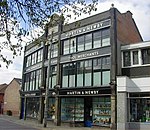St Pancras Church, Ipswich
1861 establishments in England19th-century Roman Catholic church buildings in the United KingdomEnglish churches dedicated to St PancrasGeorge Goldie church buildingsGrade II listed Roman Catholic churches in England ... and 5 more
Grade II listed buildings in IpswichGrade II listed churches in SuffolkRoman Catholic churches completed in 1861Roman Catholic churches in IpswichUse British English from November 2013

Saint Pancras is an active Roman Catholic parish church serving the town centre of Ipswich, England. The neo-gothic church was built as part of the British Catholic revival in the nineteenth century, and was the target of anti-Catholic riots soon after completion.
Excerpt from the Wikipedia article St Pancras Church, Ipswich (License: CC BY-SA 3.0, Authors, Images).St Pancras Church, Ipswich
Woodbridge Road,
Geographical coordinates (GPS) Address Nearby Places Show on map
Geographical coordinates (GPS)
| Latitude | Longitude |
|---|---|
| N 52.05575 ° | E 1.1588333333333 ° |
Address
Woodbridge Road 3
IP4 2RA , California
England, United Kingdom
Open on Google Maps








